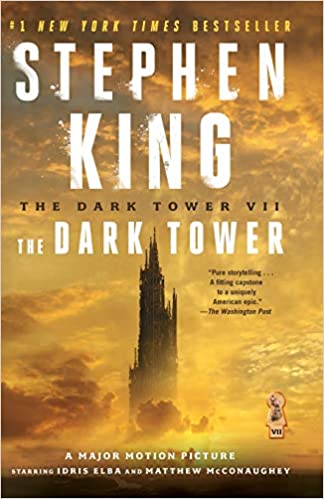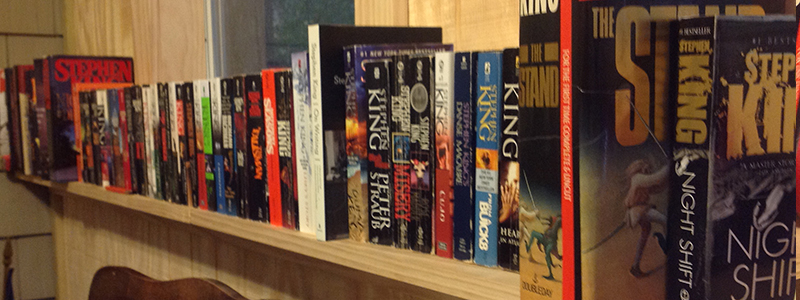by Jay Wilburn
The plan is to reread all of Stephen King’s works in the order that they were published. Richard Chizmar of Cemetery Dance had the vision. I’m doing it because I am a writer and I want to improve my fiction. And I love Stephen King’s stories. I think there is something to be learned through this process.
You can also go back to the beginning and read Before Carrie or any of my other posts up through this one and beyond by checking out this link to the Master List of all my #StephenKingRevisited posts.

I feel like I read multiple books with this final volume in the series, the titular The Dark Tower. It’s appropriate that it received four subtitles: Reproduction/ Revelation/ Resumption/ Redemption. Probably the word “Sacrifice” might have been a more appropriate umbrella subtitle, but it doesn’t start with an “R”, now does it?
It opens on a battle instead of building toward one like the previous books. Father Callahan finds his redemption after the author lost track of him at the end of Salem’s Lot.
Stephen King mentions an object of some importance rolling under a table, and there “like a certain paper boat you may remember, it passes out of our tale forever.” This final novel in the Dark Tower series may be the most meta and self-referential of all his work. In the author notes at the end, King addresses the possibility that this may be meta fiction, a term he apparently despises very much, but leaned into heavily during the writing of this book anyway. How can it not be when he literally writes himself and his own books into the story?
King is a character in this latter half of the series. The other characters reference him often and he appears as he was in 1977 and he appears as he was on a fateful day in June of 1999. In the spirit of the meta story, he refers to himself as a machine of the gods and later interjects himself in for a crucial save referencing his work as deus ex machina. Very meta. A dying robot is reading The Dead Zone. It is quite strange to have Stephen King including himself and the person who hit him as integral characters in the story. In the author’s notes, Stephen King says his wife told him to not go so far as to give directions to their house. He came close.
A character wonders aloud after a message comes through a dream, “I wonder if Stephen King ever uses dreams in his writing. Yeast to make the plot rise.” That’s one spin on it, I guess. Of course, the answer is a resounding, yes! King gets away with more dream sequences than any twelve editors would allow from all the work from all the authors that pass under their red pens in all their years. I’m past fifty books in this #StephenKingRevisited effort, so clearly the practice has not deterred me to any degree.
Roland equates poetic license with pretty lies.
In another meta moment, King pulls away from a straight narration to tell us he is “moving us closer to what you do not want to hear, and I do not want to tell you.” In the midst of a complicated battle scene, he goes back to a character mentioned earlier and asks the reader directly, “Remember him?”
As the characters in the story reference the character of Stephen King, King the author has a character state that storytellers are cut from the same cloth. They tell stories because they are afraid of life. Is King giving a deprecating self-evaluation of himself or putting the words of critics and detractors into the mouth of a character upset at the author in the story?
A docker’s clutch is King’s new obsession word. Everyone carries their gun in one in King’s universe now. The last 100 pages of the book, King fell in love with the word “conning.”
A number of reversals take place during a birthing process. Throughout the novel characters change their minds and disagree with the assertions and assumptions of allies. At times, it feels like King changed his own mind about pieces and themes he placed in the novel or the broader series earlier. Other times, it feels like the chaos of real life.
The monsters in the book are selling tickets to September 11, 2001. Always mind the mind traps when fleeing from such creatures as these. Other times, you have to run headlong through darkness to stay ahead of unspeakable creatures who escape to todash darkness between worlds.
The scenes involving assigning a caretaker to the rose, of establishing a corporation around that objective, could have been dull and purely plot serving, but King wrote it masterfully. It was oddly inspiring, important, and worthy.
Love vs. hate with love being the ever more destructive weapon is a powerful and unsettling theme in this final stretch of the gunslinger’s journey. The half-human son of the Crimson King indicates his father believes bringing the Tower down will start everything over in some way. The Crimson King seems mad and happy enough with ruling the darkness. Is the Crimson King a prisoner? Is his strange son a hint of the Old Red Father’s true form?
Randal Flagg may have always had the same goal as Roland: to reach the Tower and climb to see who lived at the top. We discover Flagg’s true origins here, his real name, and see the culmination of his storyline in the most unexpected way.
Characters from all over the Stephen King universe are making appearances now. King states a character is unimportant to the story and then takes a few pages to describe him.
The sneetches, lightning bolts, and a robot named Dobby called a house elf make appearances here. Robert Browning’s poem “Childe Roland to the Dark Tower Came” is referenced directly in this novel and then is included in the appendix. Every inspiration is an echo and whisper of something that exists in some other universe.
In a great battle, King breaks between scenes of overlapping action by having a divided conjunction.
And —
It is an effective technique in this case to show the chaos and frenzy of the conflict.
When ka-tet is broken, the end comes quickly, King says… but we’re still less than halfway through the book, so it couldn’t be that quickly. Quickly in the scope of seven volumes, I suppose. More than half of a 1050 page book is still a lot of ending. The story breaks the group to make the final miles to the Tower more bitter.
“Never” is the word God listens for when he needs a laugh. This is a good line.
“There’s little in life so disheartening as constant cold.” This struck close to home to me. I hate the cold.
“EEEEEE!” is Stephen King’s spelling for a crazy person screaming.
A character has a dream and decides they’re leaving. That’s one way to write them out.
As we approach the end of the story, the characters could drive there in a day with vehicles they find and are offered as much. But, no, decides the man dogging this Tower for his entire life, he needs more time to prepare, so he decides to go on foot which causes more trouble as it allows the author the space to tie up his plot points. Maybe it would be better to take the ride if you ever get another chance.
King struggles to capture the moment Roland sees what he’s always longed for, but still does an admirable job with it.
Like in The Talisman, King offers the reader an out. Stop here and the ending is happy enough. He reveals a bit about himself hating endings. He feels they never match up to the power and promise of “once upon a time.”
“Each man owes a death” is a part of Roland’s prayer. Ka is a wheel, and it starts things again. But maybe it will be different next time around. Our greatest moments of triumph are inarticulate. My next post in this series will be Before Faithful which will be linked on the Master List of all my Stephen King Revisited posts.





